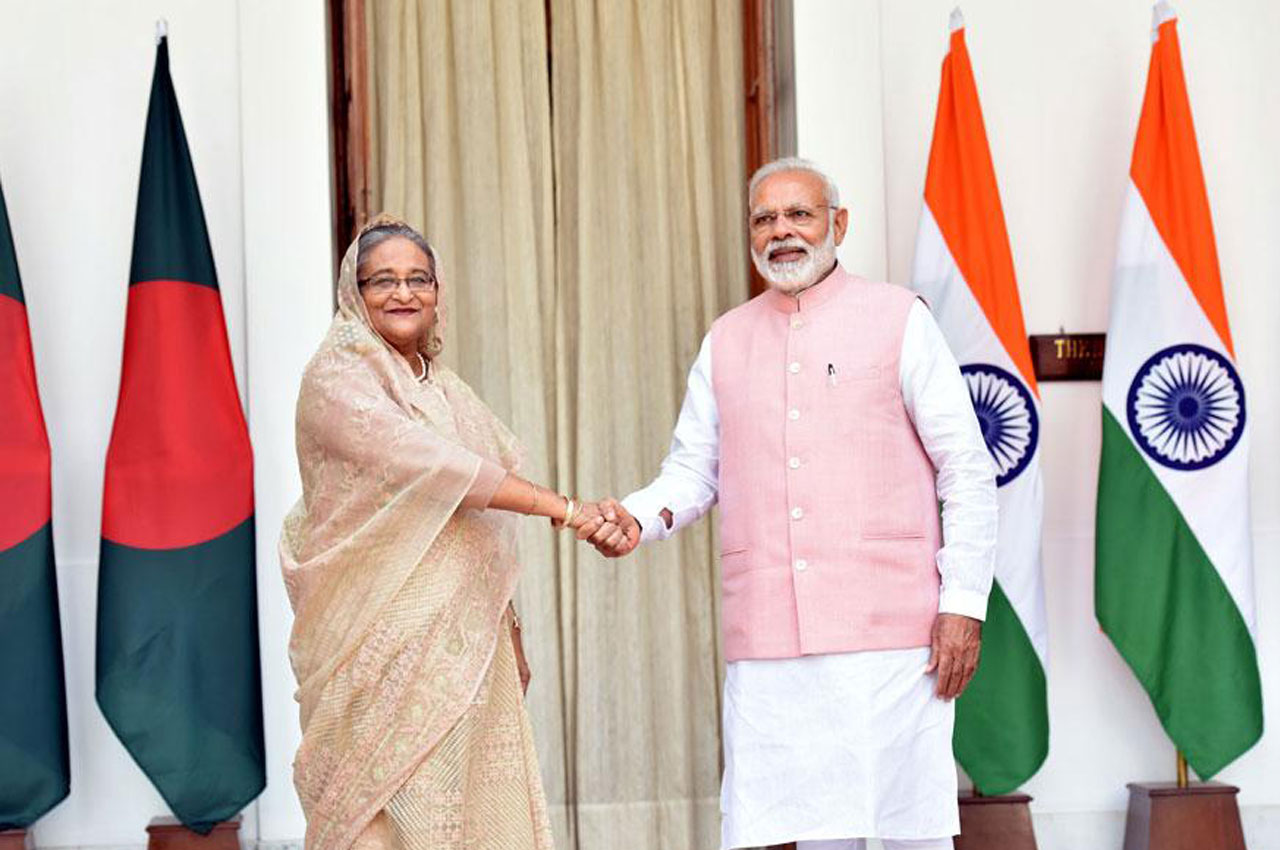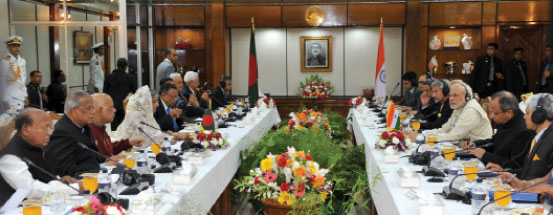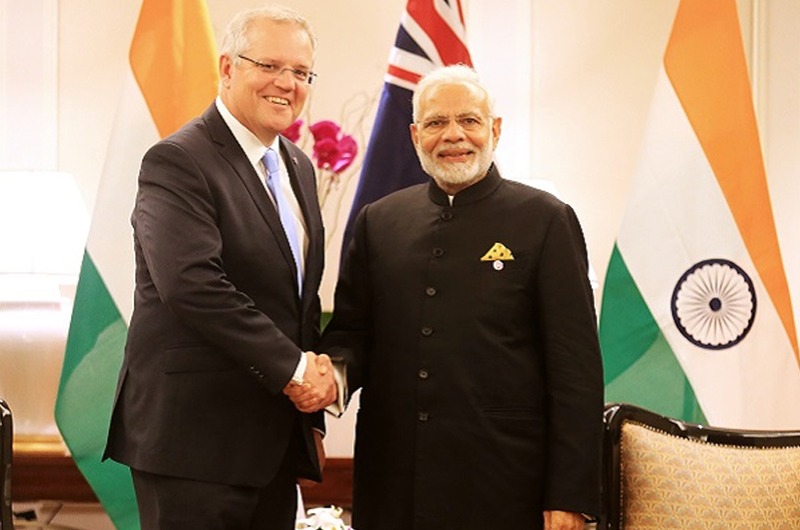By Sadaf Choudhry
“Building a comprehensive and equitable partnership with Bangladesh is essential for the realisation of our vision of a stable, secure and prosperous South Asia. History and geography have destined us to live together. How we do so is within our hands, and our hands alone”: Sushma Swaraj, India’s External Affairs Minister (EAM)
 Today India shares a deep bond of bonhomie with Bangladesh – a bond that is characterised by long-held historical, civilizational, cultural linkages (considering the people of the two neighbouring countries have a shared passion for literature, art and music), extensive economic and trade interests, and a convergence on major bilateral and international issues. Indeed, the above statement by Indian EAM Sushma Swaraj aptly sums up the importance and the future direction of bilateral engagements that the establishment at New Delhi and Dhaka wish to pursue in the coming times.
Today India shares a deep bond of bonhomie with Bangladesh – a bond that is characterised by long-held historical, civilizational, cultural linkages (considering the people of the two neighbouring countries have a shared passion for literature, art and music), extensive economic and trade interests, and a convergence on major bilateral and international issues. Indeed, the above statement by Indian EAM Sushma Swaraj aptly sums up the importance and the future direction of bilateral engagements that the establishment at New Delhi and Dhaka wish to pursue in the coming times.
Flipping through the pages of the history, the significant role played by India and its leadership in the birth of this very neighbouring nation is not something that can be overlooked easily. Who could deny the political and personal role of the former Indian Prime Minister, Indira Gandhi, in the Bangladesh Liberation War of 1971, as it was her who (with a steely resolve, for which she has been known for all along) decided to stand against the Pakistan army’s widespread genocide against the Bengali population of the then ‘East Pakistan’ in December 1971. So, while this intervention, on one hand, brought a conclusion to the war in nine short days, it also immortalised the Indira Gandhi’s role as a saviour in the history of today’s Bangladesh that we now know it. Soon after, India established diplomatic relations with the country immediately after its independence in the same year. No wonder, given her role in the country’s independence, the Sheikh Hasina government has conferred the Bangladesh Swadhinata Sammanona on Indira Gandhi posthumously.
Present
India’s relationship with Bangladesh has been one of its best success stories in the neighbourhood. Today, India and Bangladesh are not just bound by historical, religious, cultural, linguistic and kinship ties but people-to-people relations constitute a significant aspect of the bilateral relations between the two nations. It has been estimated that the Indian missions in the neighbouring country issue nearly half a million visas every year for the Bangladeshis. They visit India for treatment, education, pilgrimage, business, tourism and many other purposes. The current level of strong bonhomie is evident by a recent survey by Pew Research Center that tells that 70 percent of Bangladeshis expressed a favourable opinion and perception of India.
Going forward, the way majority envisions the future roadmap for the two nations is well stated by Bharatiya Janata Party (BJP) leader Ram Madhav who recently said that India is not a big brother, but a big partner to Bangladesh and should be seen as such.
Strengthening G-to-G Bond
Over the last few decades, the two countries have continued to consolidate their relations and have built a comprehensive institutional framework to promote bilateral cooperation in all areas. One could note, India’s bilateral engagement with Bangladesh has broadened and deepened ever since Bangabandhu Sheikh Mujibur Rahman’s daughter Sheikh Hasina returned to power in January 2009.
The current Modi-led Govt seem to be focusing on furthering the cause once charted by the previous NDA government led by Prime Minister Atal Behari Vajpayee had tried to forge close ties with regional partners including with Dhaka, and in a way redefining India’s not- so flexible foreign policy that largely focussed on bettering relations with few select partners only. And this is indeed the need of the hour.
Current Positioning
The National Democratic Alliance (NDA) government is aware of the importance of this eastern neighbour of India that holds key to India’s Act East’ foreign policy plank due to its strategic location and resource potential. Modi has already made his mark by not just pronouncing the ‘neighbour first’ policy but also taking it to its logical conclusion by visiting most of the neighbouring countries and placing the relationships with them high on his government’s foreign policy agenda. Indeed, PM Modi’s two-day visit to Dhaka in June 2015 was a continuation of India’s existing policy towards Bangladesh and undoubtedly the landmark visit took the India-Bangladesh ties to the next level as both the sides inked as many as 22 agreements related to road, railways, waterways, business, security, trade, infrastructure, communication, science and technology and cultural cooperation offering win –win proposition to both nations.
Solving Historical Issues
 Boosting trade and connectivity especially people-to-people relations was the focus of Modi’s visit, while Dhaka attached priority to bilateral issues like sharing of Teesta water, killing of Bangladeshi nationals along the international border, trade imbalance and cooperation in the power sector. Barring the intractable Teesta problem, Modi’s visit infused a new momentum to the bilateral ties and Bangladesh’s policy makers. Here worth mentioning is while for decades disputes ranging from territory and terrorism to water and migration had proved intractable, the way both the houses of Indian Parliament finally ratified the Land Boundary Agreement (LBA) on May 7, 2015 and showed a rare unanimity in passing the Constitution (119th Amendment) Bill to settle the lingering border dispute with Bangladesh ( thereby giving official sanctity to the Implementation of the LBA After a gap of 41 years), could indeed be regarded as the most significant development for both nations in recent history. We all know, one of the most significant aspects of the operationalisation of the LBA was a peaceful transfer of 162 enclaves—many of them were adversely possessed. India’s Ministry of External Affairs rightly described July 31 as a ‘historic day’ for both India and Bangladesh as “it marks the resolution of a complex issue that has lingered since independence”. Indeed, the implementation of the LBA came as a big relief for more than 51,000 ‘stateless’ enclave dwellers who could now choose the citizenship of either country.
Boosting trade and connectivity especially people-to-people relations was the focus of Modi’s visit, while Dhaka attached priority to bilateral issues like sharing of Teesta water, killing of Bangladeshi nationals along the international border, trade imbalance and cooperation in the power sector. Barring the intractable Teesta problem, Modi’s visit infused a new momentum to the bilateral ties and Bangladesh’s policy makers. Here worth mentioning is while for decades disputes ranging from territory and terrorism to water and migration had proved intractable, the way both the houses of Indian Parliament finally ratified the Land Boundary Agreement (LBA) on May 7, 2015 and showed a rare unanimity in passing the Constitution (119th Amendment) Bill to settle the lingering border dispute with Bangladesh ( thereby giving official sanctity to the Implementation of the LBA After a gap of 41 years), could indeed be regarded as the most significant development for both nations in recent history. We all know, one of the most significant aspects of the operationalisation of the LBA was a peaceful transfer of 162 enclaves—many of them were adversely possessed. India’s Ministry of External Affairs rightly described July 31 as a ‘historic day’ for both India and Bangladesh as “it marks the resolution of a complex issue that has lingered since independence”. Indeed, the implementation of the LBA came as a big relief for more than 51,000 ‘stateless’ enclave dwellers who could now choose the citizenship of either country.
Strengthening Border Managemet
It’s also expected that with the operationalisation of the LBA, a check on the 4,096 km-long India-Bangladesh borders, the fifth largest land border in the world will be made. On the same note, it is encouraging to note that during PM Modi’s visit, New Delhi and Dhaka signed a Memorandum of Understanding (MoU) for the prevention of human trafficking along the international border. The MoU seeks to prevent all forms of human trafficking especially that of women and children, and ensure speedy investigation and prosecution of traffickers and organised crime syndicates in either of the country.
Addressing Security Concerns
Both the sides face the common threat of terrorism and they have intensified their collaboration in the aftermath of the October 2014 Burdwan blast and more recently Dhaka Café Attack in July last year. The political leaders of India and Bangladesh realise that close cooperation between the security and intelligence agencies of the two nations is essential to contain the insurgents and radical groups which often join hands to subvert the friendly bilateral relation.
Summing Up
In short, an economically strong, secular and democratic Bangladesh is integral to New Delhi’s interests and also of the subcontinent as a whole. Apart from many ways, Bangladesh can benefit India, one could be its possible role in actualizing the aims of India’s ‘Act East’ policy, which now includes the north-eastern States. Its high time India capitalises on the full potential of its neighbouring ally for the cause.








